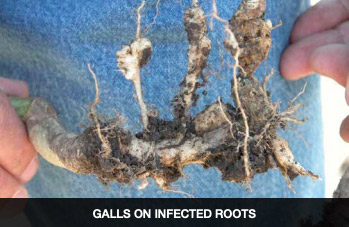Frequently asked questions about clubroot in canola.
What should growers and agronomists look for in terms of clubroot and where?
- Look for areas with premature ripening, thin canola areas.

- Scout near field entrances and areas where water has moved soil.
- Pull plants and look for gall formations on roots – if late in the season, galls may have decayed into sawdust-like brown material. DNA tests can provide confirmation.

If no patches exist, then dig up the roots of random plants near field entrances or other high-traffic areas.
Scout non-canola fields and look at brassica weeds e.g. shepherd's-purse, stinkweed, flixweed, wild mustard and volunteer canola, which can act as a host and become infected.
Be sure to consider volunteer canola as a potential source of clubroot, even if the volunteers are from a clubroot-resistant hybrid.
What is a clubroot-resistant canola hybrid?
A clubroot-resistant hybrid is a hybrid that is bred to be resistant to clubroot. This means that it is resistant to the predominant clubroot strains or pathotypes in Western Canada. No clubroot-resistant hybrids, including new ones with multiple resistance genes, are resistant to all the clubroot pathotypes detected in Western Canada to date. There is a classification system ranging from:
Resistant (R) – less than 30% infection compared to susceptible checks.
Intermediate (I) – between 30 and 50% infection compared to susceptible checks.
Susceptible (S) – more than 50% infection compared to susceptible checks.
Who should be growing a clubroot-resistant hybrid?
If you have clubroot on your farm, if you know that there are fields that are infected with clubroot in the community that you farm in, or you are concerned about clubroot you should be growing a resistant hybrid.
What is a farming community?
With respect to clubroot, a farming community is the area where you or others conduct your farming activities. If you farm across a large geography, or if you have external contractors that drive in your fields (custom work, agronomic support, etc.) and they travel larger distances, your community will be quite large.
If you find clubroot in your field(s) for the first time, what should be done?
The goal with scouting for clubroot is to find the problem early.
Pull the infected plants and either burn them or bury them in a landfill.
Lime the area to increase the soil pH – talk to your Canola Council of Canada Agronomist regarding lime sources, particle sizes and rates, as this is an area where the science is quickly evolving.
Stop the movement of dirt from 2X the area and consider planting it to grass.
Increase your canola rotation to a minimum of 1 in 3 years.
Increase the scouting on your farm.
At a minimum, tell your neighbors that you found clubroot and tell them what your management plan is. Also consider reporting to the local Canola Council of Canada Agronomist.
Grow a resistant hybrid – consider first generation genetics.
Control colunteer canola and other brassica species in canola and non-canola crops.
You've been growing a clubroot-resistant hybrid and now are noticing patches that are thin and ripening early and are seeing large galls on the roots. What should be done?
Follow the same steps outlined above with the addition of the following:
Consider having the shifted or newly introduced population pathotyped. Fields in Western Canada that have more than 1 pathotype in the soil. With the use of resistance genetics, you will control the pathotypes that your hybrid has resistance to, but over time because there are spores from other pathotypes that are not being controlled you could see the predominant pathotype shift in your field. Also, selection pressure on the pathotypes being controlled can cause genetic changes in virulence of the pathogen to overcome resistance. To get galls tested for the predominant pathotype talk to your local Canola Council of Canada Agronomist who can get it sent to the University of Alberta for pathotyping.
Grow a canola hybrid with second-generation genetics the next time you grow canola on that field.
How much yield loss can growers expect from clubroot in canola?
0 to 90+% – the following are estimates based on field observations if you do not use control measures:
1st year yield losses are typically below 1%.
2nd canola cycle: approximately 10% yield loss.
3rd canola cycle: greater than 50% yield loss.
4th canola cycle: 90% or greater yield loss.
In a confirmed clubroot field, how quickly will the pathotypes shift if you have been growing a clubroot-resistant hybrid?
It depends on your rotation. If you are farming with a short rotation (more frequent than 1 canola crop every 3 years) under a high clubroot spore load you could see the predominant pathotype shift after your second canola crop.
Under a lower spore load and a longer rotation between canola crops you will get more canola crop cycles.
What is the difference between high spore load and low spore load?
It is very difficult to quantify a low spore load, we can only tell if farmers have a high spore load – 100,000 spores per gram of soil is a high spore load.
Soil tests for clubroot spore load results could be used to assess the clubroot risk level, but the downside of this test could be that it could create problems for interpretation. Fewer spores mean lower risk, but clubroot infection can still occur at 1,000 spores per gram of soil, or less. If one field has 10,000 spores per gram and the neighbouring field has 100,000, both fields could have a problem due to potential soil movement between fields. Furthermore, if a test shows 1,000,000 spores per gram, the field is clearly at risk and symptoms are likely to appear under most conditions.
Adding to the grey area is that results can be different depending on the lab (results cannot be compared lab to lab because of their different sampling, storage, extraction and analysis protocols).
When sampling to determine the spore load in a heavily-infested area, collect samples from only that area, as a composite sample from other areas may dilute the spore concentration. Also, to get a fair estimate of spore load within a heavily-infested area, include soil from the canola row and from between the rows. (Canola Watch how to test for clubroot pathogen, 2018)
The bottom line on soil testing for clubroot is that several labs offer this service, and positive results can be a useful management tool, but negative results do not mean the field is risk-free as it could just come down to not sampling the right area.
What clubroot pathotypes is InVigor L343PC resistant to? Where should it be grown?
- The nomenclature around clubroot pathotyping continues to evolve as the science and detection methods advance. Due to this uncertainty, there is real risk that what we believe is a particular pathotype today, may actually be a population of multiple pathotypes that we have yet to understand.
- InVigor L343PC is resistant to the predominant pathotypes present across Canada, plus additional recent newer pathotypes.
- InVigor L343PC has been tested and is resistant against a wide range of clubroot pathotypes, including many of the new pathotypes that have been identified, and we are confident that InVigor L343PC is going to be effective against most of these new and emerging pathotypes.
- In fields where InVigor L340PC and InVigor L255PC cannot be grown due to the pathotypes that have overcome the resistance within these hybrids, InVigor L343PC can be used as it will perform better due to additional effectiveness against some of the new pathotypes.
- We recommend growing InVigor L343PC with second-generation clubroot resistance after two cycles of growing first-generation clubroot-resistant hybrids in clubroot-affected areas or when clubroot symptoms are noticed in first generation clubroot-resistant hybrids (whichever comes first).
For a visual tool to help you recognize when second-generation clubroot resistance is the right fit for your field, download:
What is a first-generation versus second-generation clubroot hybrid?
For InVigor
- First-generation hybrids contain resistance genetics that were initially deployed to combat clubroot for InVigor hybrid canola. This includes InVigor L340PC and InVigor L255PC. They were designed to control the predominant pathotypes in Western Canada at the time of their registration.
- Second-generation hybrids contain additional sources of resistance designed with multiple genes so that they are effective against a wider range of pathotypes.
There is currently no clubroot found on my farm or in my farming community. What InVigor hybrid should I be growing?
Grow the InVigor hybrid that best meets your needs for yield potential and agronomic characteristics (either non-clubroot resistant or first-generation clubroot resistant). Remember to keep scouting for clubroot on your farm and utilize good IPM strategies, regardless of your hybrid choice.
I have not identified clubroot on my farm, but it is a growing concern in my area. What InVigor hybrid should I be growing?
Grow a non-clubroot-resistant or a first-generation clubroot-resistant InVigor hybrid, whichever you feel performs best on your farm and in your area. Remember to keep scouting for clubroot on your farm and utilize good IPM strategies.
I have not identified clubroot on my farm, but some of my neighbors have found it on theirs. What InVigor hybrid should I be growing?
Consider growing a first-generation clubroot-resistant InVigor hybrid combined with aggressive scouting and good IPM strategies.
I have identified clubroot on my farm in non-clubroot-resistant hybrids. What InVigor hybrid should I be growing?
Grow a first generation clubroot-resistant InVigor hybrid on all your canola acres combined with aggressive scouting and good IPM strategies for managing clubroot, which includes extending your crop rotation to a minimum of 1 in 3 years. For example:
Year 1: Canola
Year 2: Wheat
Year 3: Soybean
Year 4: Canola
I have identified clubroot on my farm in non-clubroot-resistant hybrids and have grown first-generation clubroot-resistant hybrids for the last two cycles. What InVigor hybrid should I be growing?
Consider growing second generation clubroot-resistant InVigor hybrids across all your canola acres combined with aggressive scouting and good IPM strategies. First generation hybrids can still be an option, providing you actively scout for clubroot and implement a minimum 1-in-3-year crop rotation.
I have identified clubroot in my first generation clubroot-resistant hybrids. What InVigor hybrid should I be growing?
Start growing second-generation clubroot-resistant InVigor hybrids combined with aggressive scouting and good IPM strategies which includes extending your crop rotation to a minimum of 1 in 3 years.
Other companies are labeling what pathotypes they are resistant to. What is BASF's response to this approach?
The science and nomenclature are evolving, and we continue to learn about clubroot population dynamics. We also know that clubroot pathotype populations within single fields are diverse and highly variable within a field. Generalizations about a predominant pathotype can lead to poor field performance. Furthermore, there are no commercial testing facilities providing robust pathotyping for clubroot currently, so the ability to accurately determine which pathotypes are present in your field is limited.

